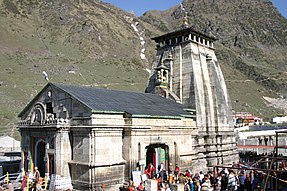At a height of 3,583 m (11,755 ft), 223 km (139 mi) from Rishikesh, on the shores of Mandakini river, a tributary of Ganga, is a stone edifice of unknown date. It is not certain who built the original Kedarnath temple and when. The name "Kedarnath" means "the lord of the field": it derives from the Sanskrit words kedara ("field") and natha ("lord"). The text Kashi Kedara Mahatmya states that it is so called because "the crop of liberation" grows here.[8]
Many folk legends related to the Garhwal region, Lord Shiva and the creation of the Panch Kedar temples are narrated.
A folk legend about Panch Kedar relates to the Pandavas, the heroes of the Hindu epic Mahabharata. The Pandavas defeated and slew their cousins — the Kauravas in the epic Kurukshetra war. They wished to atone for the sins of committing fratricide (gotra hatya) and Brāhmanahatya (killing of Brahmins — the priest class) during the war. Thus, they handed over the reins of their kingdom to their kin and left in search of the lord Shiva and to seek his blessings. First, they went to the holy city of Varanasi (Kashi), believed to be Shiva's favourite city and known for its Kashi Vishwanath Temple. But, Shiva wanted to avoid them as he was deeply incensed by the death and dishonesty at the Kurukshetra war and was, therefore, insensitive to Pandavas' prayers. Therefore, he assumed the form of a bull (Nandi) and hid in the Garhwal region.
Not finding Shiva in Varanasi, the Pandavas went to Garhwal Himalayas. Bhima, the second of the five Pandava brothers, then standing astride two mountains started to look for Shiva. He saw a bull grazing near Guptakashi ("hidden Kashi" — the name derived from the hiding act of Shiva). Bhima immediately recognized the bull to be Shiva. Bhima caught hold of the bull by its tail and hind legs. But the bull-formed Shiva disappeared into the ground to later reappear in parts, with the hump raising in Kedarnath, the arms appearing in Tungnath, the face showing up at Rudranath, the nabhi (navel) and stomach surfacing in Madhyamaheshwar and the hair appearing in Kalpeshwar. The Pandavas pleased with this reappearance in five different forms, built temples at the five places for venerating and worshipping Shiva.
A variant of the tale credits Bhima for not only catching the bull but also stopping it from disappearing. Consequently, the bull was torn asunder into five parts and appeared at five locations in the Kedar Khand of Garhwal region of the Himalayas.[9] After building the Panch Kedar Temples, the Pandavas meditated at Kedarnath for salvation, performed yagna (fire sacrifice) and then through the heavenly path called the Mahapanth (also called Swargarohini), attained heaven or salvation.[citation needed]. The Panch Kedar Temples are constructed in the North-Indian Himalayan Temple architecture with the Kedarnath, Tungnath and Madhyamaheshwar temples looking similar.
After completing the pilgrimage of Lord Shiva's darshan at the Panch Kedar Temples, it is an unwritten religious rite to visit Lord Vishnu at the Badrinath Temple, as a final affirmatory proof by the devotee that he has sought blessings of Lord Shiva.
The Mahabharata, which gives the account of the Pandavas and the Kurukshetra War, does not mention any place called Kedarnath. One of the earliest references to Kedarnath occurs in the Skanda Purana (c. 7th-8th century), which contains a story describing the origin of the Ganges river. The text names Kedara (Kedarnath) as the place where Shiva released the holy water from his matted hair
According to the hagiographies based on Madhava's Sankshepa-shankara-vijaya, the 8th century philosopher Adi Shankara died at the mountains near Kedarnath; although other hagiographies, based on Anandagiri's Prachina-Shankara-Vijaya, state that he died at Kanchipuram. The ruins of a monument marking the purported death place of Shankara are located at Kedarnath. Kedarnath was definitely a prominent pilgrimage centre by the 12th century, when it is mentioned in Kritya-kalpataru written by the Gahadavala minister Bhatta Lakshmidhara.
Kedarnath Teerth Purohits are the ancient Brahmins of this region, their ancestors (Rishi-Muni) have been worshiping the lingam since the time of Nara-Narayana and Daksh Prajapati. King Janmejay, grandson of the Pandavas, gave them the right of worshiping this temple and donate the whole Kedar region, and they have been worshiping pilgrims ever since.
According to a tradition recorded by the English mountaineer Eric Shipton (1926), "many hundreds of years ago" one priest used to hold services at both the Kedarnath and Badrinath temples, travelling between the two places daily.
